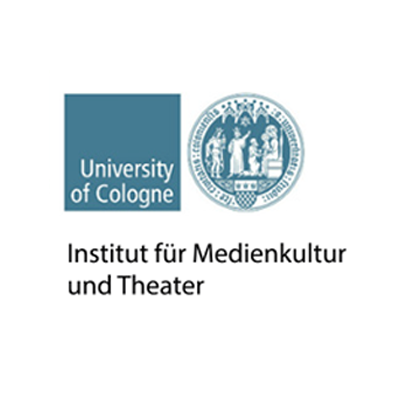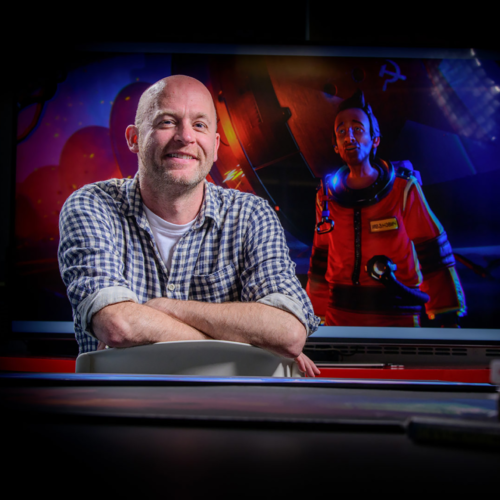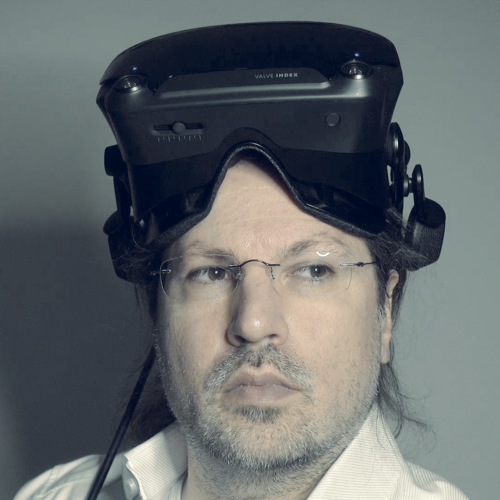


About
For the eleventh time, the Clash of Realities international research conference is providing the opportunity for interdisciplinary exchange and dialogue. Experts from the academy, science and research, economics, politics, and the game industry will discuss pressing questions concerning the artistic design, technological development, and social perception of digital games, as well as the spreading of games literacy.
The conference welcomes scholars, social scientists, game developers, specialists in education and media, up-and-coming creative talents, students, and all those interested in and excited by digital games.
This year, however, some things are different than in the past. As we all know, health and safety measures during the Covid-19 pandemic prevent us from meeting in person. Therefore, we split the conference into three parts. We are now welcoming you to part II, which will take place from July 7-9, 2021 and will be completely online. You find information about the previous part here and part III is already planned for November 17th, 2021.
For the part II, we will continue three of the summit topics from part I. Each of the summits will give a unique online presentation about pressing topics in game studies, game development, and game technologies, and discuss these topics with an enthusiastic online audience. This year’s conference – as well as the first part last year – is co-organized by the Cologne Game Lab, TH Köln – University of Applied Science – and the Department for Media Culture and Theater at the University of Cologne.
Clash of Realities - Part II
Part II of the digital conference will present three summits in three days and conclude each day with a keynote and an informal social gathering afterwards. There will also be a closed meeting of the Young Academics at the first conference day, in which they continue their work from November 2020. The results from this continued collaboration will become public in a future publication.
Each summit continues the topic from last year’s part I in panel discussions, virtual exibitions, and micro lectures. Last year’s topics that are not included in part II will be picked up again in November 2021.
We are looking forward to welcoming you online in July 2021 and in person as soon as possible for our next event in Cologne.
Program
July 7, 2021 | 16:45 – 20:00 CET – Game Development Summit
Motivation, Expectations, Innovation [more]
July 8, 2021 | 15:00 – 20:00 CET – Game Tech Summit
High Impact Trends in Games – AI in Natural User Interfaces [more]
July 9, 2021 | 16:00 – 20:00 CET – Game Studies Summit
Playful Materialities [more]
Last year's conference
See the TrailerKeynotes & Professionals
Timetable
1. Game Development Summit
July 7 16:45 - 17:00
16:45 - 17:00Welcome & Introduction
By Björn Bartholdy Cologne Game Lab, TH Köln – University of Applied Sciences, Benjamin Beil University of Cologne, Gundolf S. Freyermuth Cologne Game Lab, TH Köln - University of Applied Sciences, Klaus Gasteier Berlin University of the Arts- This talk aims to explore what ideas mean, where do they come from? What is originality and how to achieve it? By the end of the talk, the listener should get a better understanding of creativity as a process, how ideas resonate to different player motivations as well as tips for inspiration.WhereOnline
- Why do people like to play? The human predilection for play is no accident. Play is fundamental to the way that we learn. To help you understand why this is so, I shall explain the evolutionary processes that led to human play. Play and learning are essentially the same process.WhereOnline
 18:00 - 18:30
18:00 - 18:30Indie Fireside Chat with Christopher Kassulke and Björn Bartholdy
By Christopher Kassulke CEO of HandyGames™ a THQ Nordic Division and proud member of the Embracer Group, Björn Bartholdy Cologne Game Lab, TH Köln – University of Applied SciencesHandy Games has been around for over 20 years now. And under the leadership of Christopher Kassulke, the independent developer has successfully managed to retain a dedicated player base - both as a developer and, in recent years, as a publisher. Let's be curious what Christopher sees as the basis of this success story...WhereOnline- What makes a game engaging to players? Celia Hodent, former director of UX at Epic Games (Fortnite) will explore what are the ingredients that can make a game engaging, more specifically in terms of extrinsic and intrinsic motivation. Extrinsic motivation is about offering clear goals and rewards to players whereas intrinsic motivation is about satisfying players' need for competence, autonomy, and relatedness. This talk will explain how to harness our current understanding of human motivation to apply it to video game design.BusinessEngineeringGrowthPlatformWhereZoom
 19:00 - 20:00
19:00 - 20:00Keynote: The Gamer Motivation Profile: What We Learned From 500,000+ Gamers
By Nick Yee Co-Founder, Quantic FoundryGaming motivations vary across gamers in systematic and important ways. This is a data-driven talk based on the over 500,000 gamers who have taken the Gamer Motivation Profile. After a brief review of how we developed the motivation model, we'll highlight some of the more interesting findings we've uncovered over the past few years (from both research and client work perspectives), such as: using the motivation data to visualize the competitive landscape within a game genre, rethinking assumptions about how gender and age impact motivations, cross-cultural differences between US and Chinese gamers, and different ways of creating player segments.WhereOnline- 20:00 - 21:00
Digital Get Together
2. Game Technology Summit
July 8 15:00 - 15:15
15:00 - 15:15Welcome & Introoduction
By Roland Klemke Cologne Game Lab, TH Köln – University of Applied Sciences, Martin Lorber Electronic Arts, Sebastian von Mammen Games Engineering, University of Würzburg 15:15 - 15:45
15:15 - 15:45A Framework for Interactive, Autonomous and Semantic Dialogue Generation in Games
By Richard Davies Birmingham City University, Carlo Harvey Birmingham City University, Nathan Dewell Birmingham City UniversityImmersive virtual environments provide users with the opportunity to escape from the real world, but scripted dialogues can disrupt the presence within the world the user is trying to escape within. Both Non-Playable Character (NPC) to Player and NPC to NPC dialogue can be non-natural and the reliance on responding with pre-defined dialogue does not always meet the players emotional expectations or provide responses appropriate to the given context or world states. This paper investigates the application of Artificial Intelligence (AI) and Natural Language Processing to generate dynamic human-like responses within a themed virtual world. Each thematic has been analysed against human-generated responses for the same seed and demonstrates invariance of rating across a range of model sizes, but shows an effect of theme and the size of the corpus used for fine-tuning the context for the game world. 15:45 - 16:15
15:45 - 16:15Immersive Multimodal Environments for Psychomotor Skills Training
By Khaleel Asyraaf Mat Sanusi TH Köln, Cologne Game Lab, Roland Klemke Cologne Game Lab, TH Köln – University of Applied SciencesModern immersive multimodal technologies enable the learners to completely get immersed in various learning situations in a way that feels like experiencing an authentic learning environment. These environments also allow the collection of multimodal data, which can be used with artificial intelligence to further improve the immersion and learning outcomes. The use of artificial intelligence has been widely explored for the interpretation of multimodal data collected from multiple sensors, thus giving insights to support learners’ performance by providing personalised feedback. In this paper, we present a conceptual approach for creating immersive learning environments, integrated with multi-sensor setup to help learners improve their psychomotor skills in a remote setting.WhereOnline 16:15 - 16:45
16:15 - 16:45Immersive Game Technologies for Innovative Education - A Method for Experimental Interdisciplinary Technology Transfer
By Melina Rose Cologne Game Lab, TH Köln - University of Applied Sciences, Khaleel Asyraaf Mat Sanusi TH Köln, Cologne Game Lab, Roland Klemke Cologne Game Lab, TH Köln – University of Applied SciencesImmersive, sensor-enabled technologies such as augmented and virtual reality expand the way human beings interact with computers significantly. While these technologies are widely explored in entertainment games, they also offer possibilities for educational use. However, their uptake in education is so far very limited. Within the ImTech4Ed project, we aim at systematically exploring the power of interdisciplinary, international hackathons as a novel method to create immersive educational game prototypes and as a means to transfer these innovative technical prototypes into educational use. To achieve this, we bring together game design and development, where immersive and interactive solutions are designed and developed; computer science, where the technological foundations for immersive technologies and for scalable architectures for these are created; and teacher education, where future teachers are educated. This article reports on the concept and design of these hackathons.- 16:45 - 17:15
Coffee Break
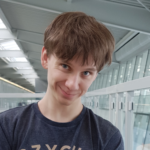 17:15 - 17:45
17:15 - 17:45ML Matchmaking Models: Enhancing Prediction With Artificial Player Data
By Tomasz Korbak University of Sussex (UK), Daftmobile, Przemysław Chojecki Mathematical Institute, Polish Academy of Science, Daftmobile, Contentyze, Michał Dąbrowski Warsaw University of Technology, Daftmobile, Marcin Wardaszko Kozminski University, DaftmobileMatchmaking is the core functionality for on-line games and esports. It can determine player satisfaction, engagement level, and ultimately player retention. The majority of the modern matchmaking systems are based on data-driven mechanisms such as outcome prediction models. All those models need a lot of data for an accurate match-up prediction and classification. However, new games or games with substantial changes to the game mechanics, usually, do not provide the required amount of data for accurate prediction. In the article, we explore the possibility of enhancing natural player-generated data with artificial bot-generated data. In a comparative experimental study, we compare different data sets and test them for accurate classification of players. We use a Naive Bayesian classifier and a Siamese neural network for model training and testing. The Naive Bayesian model shows a statistically significant increase in accuracy for data set composed of player-generated data enhanced with bot-generated data. Both models give meaningful insights into the classification process and implications for further studies. 17:45 - 18:15
17:45 - 18:15Overlapping Architecture: Implementation of Impossible Spaces in Virtual Reality Games
By Rafael Epplée Game and Web Developer (independent), Eike Langbehn Hamburg University of Applied SciencesNatural walking in virtual reality games is constrained by the physical boundaries defined by the size of the player's tracking space. Impossible spaces, a redirected walking technique, enlarge the virtual environment by creating overlapping architecture and letting multiple locations occupy the same physical space. Within certain thresholds, this is subtle to the player. In this paper, we present our approach to implement such impossible spaces and describe how we handled challenges like objects with simulated physics or precomputed global illumination.WhereOnline 18:15 - 18:45
18:15 - 18:45Interactive Self-Assembling Agent Ensembles
By Samuel Truman Games Engineering, University of Würzburg, Sebastian von Mammen Games Engineering, University of WürzburgIn this paper, we bridge the gap between procedural content generation (PCG) and user-generated content (UGC) by proposing and demonstrating an interactive agent-based model of self-assembling ensembles that can be directed though user input. We motivate these efforts by considering the opportunities technology provides to pursue game designs based on according game design frameworks. We present three different use cases of the proposed model that emphasize its potential to (1) self-assemble into predefined 3D graphical assets, (2) define new structures in the context of virtual environments by self-assembling layers on the surfaces of arbitrary 3D objects, and (3) allow novel structures to self-assemble only considering the model's configuration and no external dependencies. To address the performance restrictions in computer games, we realized the prototypical model implementation by means of an efficient entity component system (ECS). We conclude the paper with an outlook on future steps to further explore novel interactive, dynamic PCG mechanics and to ensure their efficiency.WhereOnline- 18:45 - 19:00
Coffee Break
 19:00 - 19:30
19:00 - 19:30Industry Talk: Generative Content Creation in Open World Games
By Han Liu Electronic ArtsCreating a vast and realistic terrain environment is time consuming in game development, while modeling a believable urban city is even more complicated. Han Liu will introduce how she leverage AI, specifically Generative Adversarial Networks, to assist artists prototyping a large open world environment, with very few inputs. In this talk, she will illustrate two use cases to show how generative networks open a door to learn content generation from real-world data, including style transfer of landform details on heightfield, and building footprints generation on GIS maps.WhereOnline 19:30 - 20:00
19:30 - 20:00Industry Talk: Deep Learning for Character Animation and Control
By Sebastian Starke Electronic ArtsSebastian Starke will present about the most recent advances in data-driven character animation and control using neural networks. Creating key-framed animations by hand is typically very time-consuming and requires a lot of artistic expertise. Instead, by learning from motion capture data, several works applying deep learning for character animation have demonstrated being able to produce high-quality motion controllers for complex tasks, such as biped and quadruped locomotion, object interactions or sports animations. Those works were found being able to compete with, or even outperform the quality that could be achieved by traditional techniques or professional animators, while heavily compressing the motion data and generalizing to novel situations. He will showcase a number of results using such AI-driven character controllers, present how such systems generally work, what makes them different from existing solutions, how they can integrate with current animator workflows, and which potential impact they may have on future technology for video game development.WhereOnline
3. Game Studies Summit
July 9 16:00 - 16:05
16:00 - 16:05Welcome
By Benjamin Beil University of Cologne, Gundolf S. Freyermuth Cologne Game Lab, TH Köln - University of Applied Sciences, Hanns Christian Schmidt University of Cologne 16:05 - 16:30
16:05 - 16:30Introduction: The Changing Stakes of Gaming’s Material Culture in the era of Live-Streaming
By Tom Apperley Tampere University, Centre of Excellence in Game Culture StudiesThe increasing importance of streaming and social media platforms for gaming cultures raises important issues regarding the status of the material culture of gaming. The ‘stuff’ of gaming is no longer confined to the living room or bedroom, rather these previously intimate objects are turned outwards, becoming a part of publicly expressed identities and affiliations which are complex and multiple. This suggests the need to engage with platformitization as well as platforms, the role of aesthetic, emotional and relational labor in gaming cultures, in order to consider the present—and potential legacies—of the material culture of gaming.WhereOnline 16:30 - 17:00
16:30 - 17:00Ludo Lego Literacies - Exploring Game Literacy, Brick by Brick
By Hanns Christian Schmidt University of CologneCan you teach game literacy with Lego bricks? Maybe! Even though playing and learning are intrinsically linked, research dealing with game-based-learning often ignores the issue of how we learn to 'read' games themselves. This “game literacy” (Apperley/Beavis 2013) or “ludo literacy” (Zagal 2010) deals with questions of how we acquire the necessary knowledge about "playthings" (Crawford 2009), how we learn to use them, how we find out about the effects of certain game mechanics, how we interpret them as expressive artefacts and even how we can use this literacy to ‘game’ other systemic processes in our society (Zimmerman 2009). This presentation outlines a possible mediation of game literacy by offering a closer look at the Game Literacy Arcade Machine (a.k.a. Dario’s Box) – an Augmented Reality technology which functions as a platform for the experimental game “A Maze in Tiles." Framed within informal game design workshops in the City Library of Cologne, the tool gives children the ability to construct their own maps with bricks, to add game design elements, and to turn them into mazes that can be explored in the first-person perspective. This method is based on a constructionist approach, "extend[ing] the idea of manipulative materials to the idea that learning is most effective when part of an activity the learner experiences as constructing a meaningful product" (Papert 1989). Both hardware and software are the results of the research project “Playgrounds of Game Literacy”, a collaboration between the Institute of Media Culture and Theater (University of Cologne) and the Cologne Game Lab (TH Köln). -- Apperley, Tom & Beavis, Catherine (2014): “A Model for Critical Games Literacy.” The Journal of Digital Learning and Teaching Victoria (1): 46-54. Crawford, Chris (2009): “The Archaeology of Play Things: Theorising a Toy Stage in the 'Biography' of Objects.” Childhood in the Past (2): 55 - 70. Papert, Seymour (1987): Constructionism: A New Opportunity for Elementary Science Education. Abstract Summary. Online: https://nsf.gov/awardsearch/showAward?AWD_ID=8751190, last accessed 24.06.2021. Zagal, José (2010): Ludoliteracy: Defining Understanding and Supporting Games Education, Pittsburgh, PA, USA 2010. Zimmerman, Eric (2009): “Gaming Literacy Game Design as a Model for Literacy in the Twenty-First Century”, in: Binder, Thomas u.a. (eds..): (Re)searching the digital Bauhaus, London 2009, 179–190. 17:00 - 17:30
17:00 - 17:30Adventure Soil Life - museum4punkt0: A VR Animation on Scary Animals to Raise Positive Emotions for the Relevance of a Neglected Ecosystem
By Lutz Westermann .hapto GmBH, Willi Xylander Senckenberg Museum for Natural HistoryLutz Westermann and Willi Xylander present the project museum4punkt0.WhereOnline 17:30 - 18:00
17:30 - 18:00NMsee
By Anna Riethus Federation of the Blind and Partially Sighted Nordrhine / Neanderthal Museum Foundation, Thorsten Unger Founder and CEO of Wegesrand GmbH & Co. KGAnna Riethus and Thorsten Unger present the inclusive mobile game NMse.WhereOnline 18:00 - 18:30
18:00 - 18:30HIDDEN CODES - Mobile Game about Radicalization in the Digital Age
By Martin Thiele-Schwez Playing History UG & Co. KGMartin Thiele-Schwez presents the mobile game Hidden Codes.WhereOnline 18:30 - 19:00
18:30 - 19:00Playing for Ludounity: Teddies and Toy Activism in Time of the Pandemic
By Katriina Heljakka University of TurkuIn March 2020 teddy bears and other plush toys were brought to the windows in New Zealand, Australia, Europe and North America. The world’s most popular character toy sat in the windows, often holding hands or giving hugs to other toyfriends, depicting the longing for human closeness with its gestures. As an intergenerational form of material-digital and screen-based play, the playing enabled communication between players separated by the pandemic: Various toy personalities were used to share solidarity, compassion and channel a positive spirit. The play pattern based on toy displays and photoplay (toy photography) was also accompanied by a gamified goal— a challenge based on the spotting of teddies online and offline that attracted players of different ages. Inviting children and adults to make, narrativize, and hunt for toy displays, the challenge became a popular phenomenon widely covered by the media across the globe. This talk addresses the Teddy Challenge as an example of creative and intergenerational play, which developed into an international phenomenon in the early stages of the COVID-19 pandemic. Imagination, inclusion and communality were the most main features of the play pattern showcased by everyday players as well as enterprises and authorities. As proposed in the talk, the Teddy Challenge with its aspects of resistance, resourcefulness, and resilience, represents a form of toy activism, in which toy characters act as messengers of socially significant statements. By playing for the common good by combining character toys with online sharing, the imaginative acts of physical object displaying, socially shared photoplay and hybrid play culture thrive and channel a strong, message of ludounity: By playing together, we will survive. The appetite for play is a sign of mental strength and playful resilience—willingness to sustain well-being—human psychological endurance and survival. Where there is play, there is a way.WhereOnline 19:00 - 20:00
19:00 - 20:00Keynote: Samples, Prototypes, and Storage Rooms – Why We Stopped Building Games
By Nathalie Pozzi Principal, Nakworks, Eric Zimmerman Arts Professor, NYU Game CenterNathalie Pozzi, Italian architect and Eric Zimmerman, American game designer, have designed several large-scale physical installations that bridge their disciplines of architecture and game design to play with social and physical spaces. In this talk, they reflect on their work together as a material practice. Looking back over several projects, they discuss how their design approach has evolved from an impulse to invent pristine artificial spaces to an embrace of the messy world as it already is.WhereOnline 20:00 - 20:15
20:00 - 20:15Outlook Clash 2021 - Part III
By Björn Bartholdy Cologne Game Lab, TH Köln – University of Applied Sciences, Benjamin Beil University of Cologne, Gundolf S. Freyermuth Cologne Game Lab, TH Köln - University of Applied Sciences
4. Young Academcs Workshop
July 7 - Open only for Participants 09:45 - 10:00
09:45 - 10:00Welcome and Introduction
By Jimena Aguilar ifs Internationale Filmschule Köln, Miruna Vozaru IT University of Copenhagen, Felix Zimmermann a.r.t.e.s. Graduate School for the Humanities Cologne, Su-Jin Song Cologne Game Lab, TH Köln – University of Applied SciencesWhereZoom- Imagine a virtual world, in which you can do everything and at the same time do not have to do anything at all. David OReilly’s open-ended simulation Everything (2017) is precisely such a game; one which tends to take over the reigns of play. On the one hand, it invites the player to a sandbox-like exploration, giving them the possibility to get into the shoes of every creature possible. On the other, if left unattended, it starts playing in the background, automatically generating an ambient aquarium of universes. Ambient play is a peculiar phenomenon. It challenges, if not undermines, traditional video game aesthetics, which relates to an experience of focusing one’s attention closely on the aesthetic object and reconfiguring it through physical interaction. Ambience sits comfortably between action and non-action, relevance and irrelevance or immersion and emersion. The player plunges into the world, just to be out of it the next minute, letting the application run in the background. This short keynote will explore a variety of ambient ludic practices and propose theoretical approaches to study ambience in/at play.
 10:20 - 10:40
10:20 - 10:40Sounding the Atmosphere
By Björn Redecker Faculty for Educational Science, University of BielefeldSound plays a crucial role in creating virtual worlds. It is a vital part of digital games, fillingthem with life and undoubtedly enhancing the experience for players. Ever since Al Alcorn“poked around the sync generator to find an appropriate frequency or a tone” (Alcorn in Kent 2001, p. 42) for Pong (Atari 1972) and created the bip that broke the silence that had left digital games incomplete, virtual worlds have become livelier, more authentic and, above all, the audio- visual form of media as we know it today. The very same can be said about “music, as the ordered succession of sound” that serves as “a vehicle for the transportation of atmospheric values” (Herzfeld 2013, p. 147, see also Haffter 2015, p. 9). In fact, the very first examples of Game Music were comprised of “the sounds that were already in the machine” (Alcorn in Kent 2001, p. 42). Game Sound as well as Game Music are key design elements in the sense that they can greatly support visual efforts to create an atmosphere and are furthermore capable of evoking as well as adding to different atmospheres themselves. From a design perspective, they are neither an afterthought, nor a passing fad, as “music is not a redundant echo of other aspects of the game, but […] a central part of the audiovisual experience” (Summers 2018, p. 6). This is due to the immediate nature of sound and music, whose direct connection to our feelings and emotions has been a frequent talking point in historic musicology.1 However, how exactly this immediate connection works has never been clearly defined or fathomed and remains a major point of contention within the musicological community (see Mies 1912, p. 399). As mentioned in the Call for Papers, the term ‘atmosphere’ is hard to grasp. It is frequently used but rarely broken down to what it really means or implies. At the same time, ‘writing about music is like dancing about architecture’2, which further complicates the issue. Albeit these difficult prefixes, this paper aims to describe and discuss the interrelationship between sound, music, and atmosphere. In doing so, it will address the connection between music and space and touch upon techniques like ‘Tonmalerei’ (tone painting), constituting musical elements such as texture as well as musical concepts like musique concrète. It will use examples from games like Inside (Playdead 2016), Kona (Parabole 2017), The Longest Journey-Series (Funcom and Red Thread Games 1999-2014), Virginia (Variable State 2016) and others.WhereZoom 10:40 - 11:00
10:40 - 11:00Generative Atmospheres: Digital Games and Ambient Works
By Vadim Nickel Cologne Game Lab, TH Köln – University of Applied SciencesIn the liner notes for his 1978 album Ambient 1: Music for Airports, Brian Eno stated that ambient music must be as ignorable as it is interesting. He identified ambient music as a genre that can be engaged over various levels of intensity, from being merely a calm auditive layer at an otherwise busy airport to holding the full attention of the listener, encompassed in its spherical sounds. When applying this idea to digital games, a new kind of game emerges: the ambient game. Adapted from Eno’s concept, the ambient game can be experienced on different layers of engagement, which vary in intensity: It may serve as a screensaver when devoid of player input, as a walking simulator for mere spatial exploration, and subsequently as an interactive ludic experience, the nature of the interactivity depending on the game genre. This paper aims to present ambient games as playable atmospheres by iterating through the aforementioned layers of engagement in a reversed order: As layers of interaction are removed, atmosphere emerges as the underlying structure. The removal of interaction layers in games is not a new practice and has been performed in the context of artistic game modifications. One such example is Cory Arcangel’s 2002 work Super Mario Clouds. In the context of ambient games, however, one shall differentiate between a voluntary removal of interaction layers, dependent of the player’s decision not to engage, and embedded or integrated removal, which is static and may not be simply reversed, such as in Arcangel’s work.WhereZoom 11:00 - 11:20
11:00 - 11:20Experimental Cinema & Video Games: Atmospheres Expanded
By Felipe R. Martínez ifs Internationale Filmschule KölnIt is generally accepted that VR offers a broad range of possibilities for narration and sensorial experiences. However, the limitations of mainstream cinema language for VR narration development are increasingly apparent. This particular media-history conjuncture has a precedent one hundred years ago: The birth of cinema and the exploration of experimental film, which attempts to hack the psyche perception of the very fabric of reality, as well as breaking the self-referential logic of theater and literature. In this paper, I attempt to establish a connection between techniques ofExperimental Cinema and the creation of avant-garde sensorial atmospheres for VR.This paper is divided into 3 broad parts: Part 1 provides an analysis of theory and praxis in the works of Dziga Vertov and Kino-Eye for a non-individual narrative, of Maya Deren and the staging of dreams by ritualistic modes, and Raoul Ruiz and his poetic for spiral narratives. Part 2 outlines some of the key principles behind aesthetic and technical atmospheric elements on outstanding immersive VR Experiences such as Note on Blindness, Bjork's "family", and a selection of works by the MIT-Media-Lab. In the remainder of the paper, I will focus on establishing a parallel and comparative analysis of the case of studies and its poetic and formalistic dynamics from a media theory point of view. Still, a comprehensive manual of experimental Cinema into VR is beyond the scope of this paper, and its main objective is to shed light on underlying principles and dialectic dynamics that can further enrich the development methods for the creation of deeper and newer atmospheres. Hopefully, this paper can suggest ways for a conscious craft of human-machine interfaces that transcend the limits of theatrical representation andexpand the possibilities of sensorial perception into a brand new myriad of dreams.WhereZoom- 11:20 - 11:35
Coffee Break
 11:35 - 11:55
11:35 - 11:55A Closer Look at Uncanny Atmospheres in Walking Simulators
By Katja Aller University of CologneWith a focus on gamespaces, avatars, and the player's point of view, this paper (WIP) explores the spatial atmosphere of „the uncanny“ in walking simulator games. During my past research I came across many well known walking simulator games and noticed that most of them (such as Gone Home, Dear Esther, or What Remains of Edith Finch) share the trait of an eerie mood. In my paper I want to show why this “ubiquity” of uncanny elements is more than just personal perception and how walking simulators reproduce atmospheres of the uncanny through genre specific characteristics. The definition of the uncanny used in this paper is mainly based on the works of Freud, Jentsch, Fuchs, Heidegger, and Böhme. Exploration of the gamespace is a main characteristic of the walking simulator. Many walking sims use architecture and objects to (re)produce the uncanny, a particular form of spatial atmosphere. Uncanny spaces are characterised by a certain ambiguity that arises when the familiar becomes strange. Das Heimliche becomes das Unheimliche. Both Gone Home and Edith Finch, for example, use domestic settings in which normality and alienation merge into a state of ambiguity. In both games, the protagonist returns to her family home whereby she experiences the return “[zum] Altbekannten, Längstvertraute[n]”. There, Freud locates the roots of the uncanny. The interaction between player and the digital figure of the avatar reflects another feature of the uncanny: the player controlled entity is neither dead nor alive which, according to Jentsch, is an uncanny state. Most walking simulators use first person perspective. Through this perspective, the player's sense of peripheral vision is removed. In real life, the resulting 'tunnel vision' usually occurs when the body senses fear or distress. The genre-typical POV thus adds to the uneasy atmosphere.WhereZoom 11:55 - 12:15
11:55 - 12:15Cool Japan: Commodification of Cultural Aesthetics in Ghost of Tsuhima
By Anh-Thu Nguyen University of CologneThe developers of GHOST OF TSUSHIMA (2020) made no secret about their main source of inspiration for their game set in the 13th century feudal era of Japan: “So much of our inspiration comes from samurai cinema – not just Akira Kurosawa […].” (Tapsell 2020) Rather than foregrounding a claim on historical accuracy as is often the case for so-called historical games, the developers explicitly state pop culture to be their main point of reference. How has this approach shaped the game itself? What elements were taken from modern (Japanese) pop culture to make up a distinct atmosphere of feudal Japan? What does this mean for the player? As American developer Sucker Punch Productions closely worked with their Japanese localisation team to ensure a specific atmosphere constituting 13th century feudal Japan, rather than accusing the developers of cultural appropriation, the game’s production and aesthetics can be understood as a transcultural transformation primarily derived from popular culture as well as tourist destinations and myths. As far as GHOST OF TSUSHIMA is concerned, media-critical analysis may not only look at the obvious cinema references but also at media-specific aspects of the game that are part of the game’s atmosphere: from audio-visual cues in the form of wind, birds and foxes giving directions, weather simulations and landscapes embodying specific seasons, to a player’s pilgrimage to shrines by traversing them in climbing puzzles. To expand the current scope of the field of game studies that usually does not take Japanese cultural contexts into consideration despite Japan’s immense influence on the video game market (Schules 2015, Picard and Pelletier-Gagnon 2015), this submission is part of a bigger on-going project engaging with games that are either created by Japanese developers or informed by Japanese culture.WhereZoom 12:15 - 12:35
12:15 - 12:35Systemic Atmospheres in Roleplaying Games
By Jonathan Jung Johansen ITU – IT university of CopenhagenAtmospheres are imagined spaces that yet manage to impress ourselves upon us physically, with goosebumps, frisson, or the relaxation of the tension (Pallasmaa, 2014). These atmospheres exist only inside the mind of the experiencer. Atmosphere in buildings cannot be reduced to the formal qualities of a space: Juhaani Pallasmaa argues that atmosphere is a multi-sensory, culturally involved process, particular to the place it is experienced, noting that they are an intermediate between the perceiver and the world that invokes the perceivers entire sense of being (Pallasmaa, 2014, p. 231)Gerhard Bohme argues in “The art of the stage set as a paradigm for an aesthetics of atmospheres” that the aesthetic impressions of a phenomena, its atmosphere, may be created by the tuning its environment. Bohme likens this to setting a stage, and argues that the creation of atmospheres can be understood through the concrete praxis of stage-setting (Böhme, 2013, p. 4,5). Viewed in this manner, the atmosphere is intimately tied to the situation where it is experienced, and there may be concrete procedures with which to tune the environment. Through these two lenses, roleplaying is the setting of a stage for an imaginary world, and through dialogue, all players take on the roles of both actors, authors, and set designers - finding out what will happen, rather than pre-planning it like a plot, while creating a singular atmosphere felt by all players present. As such, atmospheres experienced when playing a roleplaying game are puzzlingly imagined spaces embedded in the material qualities of imagined spaces, the suggested actions of the characters, and the actions which the players perform around the table.What I propose is the development of a model that can explain how imaged space, character actions, player actions and mechanics with particular means create, sustain, and dispel atmospheres in roleplaying games.WhereZoom 12:35 - 12:55
12:35 - 12:55"Wind's Howling": Atmospheres in Digital Games as Meteorological Phenomena and Stimmung
By Magdalena Leichter University of InnsbruckWhile seemingly functioning as a throwaway line the protagonist Geralt mutters to himself in The Witcher 3: Wild Hunt, the above-cited quote also serves as an example of how diverse the approach to atmospheres in digital games can be:Primarily, the line acts as a re-centering element, immersing players in the game's world, reminding them that Geralt feels the atmosphere around him. The line also verbalizes that the game's intradiegetic atmosphere in the sense of meteorological phenomena surrounding and influencing gameplay and story. Additionally, the line adds to the atmosphere as Stimmung, since it further roots the game in traditional Slavic folklore. Here, as a Reddit user points out, the howling wind would be interpreted as a sign of bad luck and change – two aspects adding to the game's global themes. In this contribution, I will focus on 'game-atmospheres' as remediated meteorological phenomena. My thesis is that, as a hybrid art form, digital games draw from concepts of atmospheres found in other media formats such as literature or films and the players' tacit knowledge about meteorological phenomena and their influence on cultural and societal aspects. Based on these observations, I intend to draft a concept for contextualizing different connotations for and uses of 'atmospheres' as meteorological phenomena in digital games. Although they are often viewed as mere backgrounds or accompaniments, I want to bring them to the foreground and, by taking an intermedial approach, show the atmosphere's role in producing realism, context, meaning, and Stimmung in digital games.WhereZoom- 13:00 - 14:00
Lunch Break
 14:00 - 15:30
14:00 - 15:30Group Session
By Katja Aller University of Cologne, Anh-Thu Nguyen University of Cologne, Björn Redecker Faculty for Educational Science, University of Bielefeld, Vadim Nickel Cologne Game Lab, TH Köln – University of Applied Sciences, Felipe R. Martínez ifs Internationale Filmschule Köln, Magdalena Leichter University of Innsbruck, Jonathan Jung Johansen ITU – IT university of Copenhagen, Jimena Aguilar ifs Internationale Filmschule Köln, Miruna Vozaru IT University of Copenhagen, Felix Zimmermann a.r.t.e.s. Graduate School for the Humanities Cologne, Su-Jin Song Cologne Game Lab, TH Köln – University of Applied Sciences20-30 min for each paper. Group A: Björn, Vadim, Felipe, Miruna, Su-Jin Group B: Katja, Jonathan, Anh-Thu, Magdalena, Felix, JimenaWhereZoom- 15:45 - 16:00
Questions and Next Steps
Our Speakers
Register Now
Team

Jimena Aguilar

Björn Bartholdy

Benjamin Beil

Gundolf S. Freyermuth
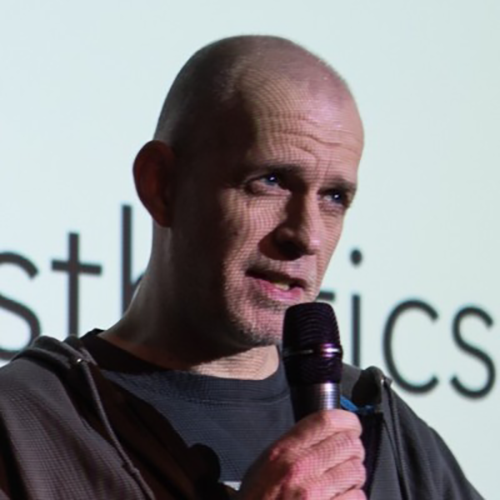
Klaus Gasteier

Odile Limpach

Nina Kiel

Roland Klemke

Hanns Christian Schmidt

Martin Lorber

Sebastian von Mammen

Pierre Schlömp

Friederike Siller

Jürgen Sleegers

Su-Jin Song

Miruna Vozaru

Felix Zimmermann

Laura Frings

Alexandra Hühner

Vanessa Ossa
Contact | Press
Department for Media Culture and Theater
Meister-Ekkehart-Str. 11
50937 Cologne
Germany
Press Contact:
Vanessa Ossa
Email: vanessa.ossa@uni-koeln.de
Phone: +49 221-470 76239
For further questions and information concerning the Clash of Realities Conference please contact us below.

